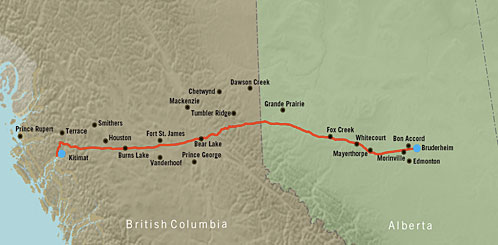The Northern Gateway
Background
Founded in 1949, Enbridge, Inc. is a multinational energy company headquartered in Calgary, AB. Employing 6,900 people, it is primarily focused on energy extraction and transportation. Enbridge’s pipeline systems comprise approximately 13,500 kilometres of pipeline, delivering more than 2 million barrels per day of crude oil and liquids.
Enbridge is currently involved with approximately two dozen projects of various size, involving expansion to existing pipelines as well as construction of entirely new pipeline routes. Among these, the Northern Gateway is easily the most high profile, and would involve the construction of a twin pipeline system spanning 1,177 km from Bruderheim, Alberta, to Kitimat, British Columbia. Announced in 2010, it’s estimated construction cost stands at $7.9 billion.
Project Specifications
The Northern Gateway is a proposal to construct a 1,177 km long twin pipeline system from Bruderheim, Alberta, to Kitimat, British Columbia. Approximately 520 kilometers of the pipeline would run through Alberta, and approximately 657 kilometers in British Columbia. The larger of the two pipelines would carry an average of 550,000 barrels of crude oil per day west, to Kitimat. The other would carry an average of 193,000 barrels of condensate (used to thin bitumen for transport) per day east, to Bruderheim.Significant geotechnical challenges exist at many points along the proposed route of the pipelines, including the risk of landslides, avalanches, and wash-outs. The pipelines’ routing would necessitate the construction of two tunnels directly through the Coast Mountains, and would cross 773 watercourses, of which 669 are fish-bearing. The project would also include the construction of a marine terminal capable of handling vessels up to the Very Large Crude Carrier (VLCC) supertanker classification. The number of tankers calling at the Kitimat Terminal would average 220 annually, bringing to an end a long-standing moratorium on tanker traffic in the region.
Environmental impacts
Between 1999 and 2010, Enbridge reported a total of 804 spills in Canada and the United States, releasing approximately 21 million litres of oil into the environment. In the summer of 2010, a ruptured pipeline operated by Enbridge resulted in 3 million litres of oil spilled into the Kalamazoo River – the single largest inland oil spill, as well as the most costly pipeline accident ever to occur in the United States. Using Enbridge-provided data, several independent studies have estimated the risk of a spill over the course of the Northern Gateway’s 30-year projected lifespan to be as high as 90%.
Inland areas of British Columbia which would be put at risk by the pipelines’ proposed route include the Parsnip River, the Murray River, the Fraser and Skeena watersheds, and the Great Bear Rainforest. Concerns over the safety of supertankers in Kitimat’s port are equally high, as the region is prone to hurricane force winds, heavy precipitation, and some of the largest recorded waves in history. In the event of a spill in or near a major watershed, the effects on fish and other marine life could be severe and irreversible. As the keystone species of the Interior and Coastal ecosystems, a major disruption to salmon populations could quickly radiate to other species for whom the fish remains the key nutrient source.
Economic Impacts
According to Enbridge’s estimates, the Northern Gateway would add $280 billion to the Canadian economy and generate $2.6 billion in net tax revenue over its 30-year lifespan. The company has also offered First Nations and Métis communities a 10% equity share in the project valued at an estimated $280 million in revenue over the next 30 years, or an average net income of $70,500 per year, per band. The project would produce a projected 4,100 temporary construction jobs, 560 permanent jobs in British Columbia and 86 permanent jobs in Alberta.
In the event of a spill at any point along the pipeline, the economic impacts to existing industries could be severe. Major sectors at risk in both Alberta and British Columbia include regional tourism, forestry, hunting, agriculture, and sport- and commercial-fishing.
However, even when the risk of a spill is excluded, the economic impacts of the Northern Gateway are difficult to forecast. While the federal government has argued that the Northern Gateway is in the Canadian national interest as it would improve access to emerging Asian markets, the volatility of these markets presents serious challenges, and may weaken national energy security. As a project undertaken for the purposes of expanding oilsands exports, approval and construction of the Northern Gateway could also sour trade relations with the European Union, where environmental regulations are far more stringent. At the broadest level, by increasing the price of oil, the Northern Gateway could inadvertently reduce Canada’s GDP and increase unemployment in non-oil industry related sectors of the economy.
Cultural Impacts
Enbridge has characterized the Northern Gateway as “a partnership between First Nations and Enbridge [that] can be considered an important bridge between Aboriginals and industry for mutual long-term benefit”. However, several high-profile grassroots campaigns have challenged this sentiment, and have indicated an overwhelming disapproval of the project on behalf of First Nations.
Along its proposed route, the Northern Gateway would intersect the traditional territories of upwards of 60 First Nations. Many continue to practice a traditional sustenance economy based on a wide range of culturally valued foods, each of which has historically had ecological, social, and spiritual significance attached to it. A spill at any point within these many traditional territories could have immediate and dire consequences, as the resources necessary for many Indigenous peoples’ sustenance, livelihoods, and continuity of cultural practices would be permanently lost.

